Physical survey on the health hazards of welding activities on welding operators in Uyo, Nigeria
Okoro CC, Odigie OM, Ozigis M
Abstract
Background: Welding operators are subjected to several forms of hazards during welding activities.
Aim: The study aimed to identify the common practices in welding operations, assess the potential health hazards associated with these practices, and propose recommendations for improving the well-being of welding operators.
Methodology: The survey was conducted at different welding workshops in Uyo, Akwa Ibom State, Nigeria. A total of 100 welding operators were observed and interviewed to gather data on their working practices and the health effects they experienced.
Results: The findings revealed that the most common welding practices included manual metal arc welding, gas metal arc welding, and gas tungsten arc welding. These practices involved exposure to various hazards such as fumes, gases, noise, and ultraviolet radiation. The survey also found that a significant number of welding operators reported experiencing health issues such as respiratory problems, skin irritation, eye injuries, and hearing loss. These health effects were attributed to the lack of proper ventilation, inadequate personal protective equipment, and poor ergonomic practices in the welding workshops.
Conclusion: The findings of this study highlights the importance of addressing the health hazards associated with welding operations to ensure a safer and healthier work environment for improved work conditions and well-being of welding operators. In light of the findings, several recommendations including the implementation of proper ventilation systems, provision of adequate personal protective equipment, regular health screening for welding operators, and training programs on safe welding practices is proposed in order to improve the well-being of welding operators.
Keywords: Welding operations, Well-being, Health hazards, Physical survey, Welding effects.
Introduction
Welding is a widely used industrial process that involves joining materials through the application of heat and pressure. Through localized coalescence resulting from a suitable combination of temperature pressure and metallurgical conditions. Welding processes are wildly used for the manufacture of mining industry, civil engineering structures, shipyards, oil and gas, petrochemical industry, transportation means and metallurgy.1,2 In today’s industries, welding has become a practice that is being employed to join many materials together. Several welding techniques like Tungsten Inert Gas welding (TIG), Shield Metal Arc Welding (SMAW), Gas Metal Arc Welding (GMAW) etc.3 has become an essential fabrication method depending on the nature of jobs involved. Several welding output parameters, such as weld width, reinforcement height, depth of penetration, hardness, impact strength, and tensile strength, among others, are used to determine the quality of the weld. Welding current, voltage, feed rate, speed of welding, electrode extension, diameter of electrode, electrode angle, etc. are welding input parameters that affect outputs of the welding operation. Metalworking is thrilling and empowering. Welders are able to shape some of the strongest materials in the world into the goods they imagine while the heat and sparks fly. It is advisable to study this practice under the advice and direction of professionals in the field because it demands effort and practice to master it.4,5 Welding practice is primarily a manufacturing, construction engineering, and maintenance activity. Welding has developed over the past few decades into an interdisciplinary activity that calls for the synthesis of knowledge from numerous fields and makes use of the most cutting-edge instruments from diverse basic and applied sciences.6 It is also interesting to observe that Welding has emerged as one of the most popular occupational groups in many developing countries as a result of rising urbanization and industrialization.7 Without welding, it would be impossible to construct anything, including cars, sky-high office buildings, rockets, and airplanes, as well as pipelines and highways. This suggests that a sizeable number of people are employed in the welding sector. Welders are defined by the International Standard Classification of Occupations (ISCO) as those who join and cut metals using flame, electric arc, and other heat sources.8 Adu and Danquah9 conducted a study on the current welding procedures and techniques used in a few specific Ghanaian metal welding sectors. The study discusses the many types of welding and welding techniques, welding quality control procedures, welding process types that are employed, and general difficulties that reduce welding productivity in Ghana. For the study, 250 welding businesses from both the formal and informal sectors were chosen from across Ghana's regions. The chosen welding industries were given designed questionnaires or enquiry forms. Out of the two hundred and fifty (250) selected firms, 200 (200), or 80%, replied to the request. The study showed the various ratios of various industry sectors and the locations where welding activities were used. The majority of industries (around 90%) were involved in manual welding operations. Moreover, Beji et al.10 in a research study assessed different welding workshop risks and welders' usage of safety procedures in Minna Metropolis, Nigeria. This descriptive, cross-sectional study examined 66 workshops in the Minna metropolitan. A questionnaire was used to collect the data, which was then processed and analyzed using SPSS version 16 software. The most frequent dangers in the workshops were manual handling, noise/vibration, and odors. Each workshop had sufficient ventilation and lighting. First aid equipment, fire extinguishers, or labels for dangerous materials were absent from every business. The majority of the workshops provided eye protection for employees, but none of the ones that were reviewed provided a helmet, apron, or hearing protection. For instance, Yetunde et al.11 opined that many Nigerian welders set up their welding shops next to the road, thus placing them at danger of being hit by swerving cars, trucks, or drunk drivers. This welding workshops may be prone to additional hazards of poor machine arrangement, cables and gang ways which can cause accident. While it plays a crucial role in various industries, the physical demands and potential hazards associated with welding operations can significantly impact the well-being of welding operators.12 Welding operators are exposed to a range of physical hazards that can have detrimental effects on their well-being. The primary health risks associated with welding operations include exposure to toxic fumes, intense heat, and harmful radiation.13 Welding fumes, generated by the vaporization of metal during the welding process, contain various hazardous substances such as manganese, chromium, and nickel. Prolonged exposure to these fumes can lead to respiratory issues, including bronchitis, asthma, and even lung cancer.14 Furthermore, the intense heat generated during welding operations can cause thermal burns, eye injuries, and heat stress. Welding operators often work in confined spaces, increasing the risk of heat-related illnesses due to poor ventilation. Additionally, the ultraviolet (UV) radiation emitted during welding can cause severe damage to the eyes and skin, leading to conditions such as arc eye, cataracts, and skin burns. This study explored the practices of welding operations and their effects on the physical well-being of welding operators. By examining the potential health risks and proposing preventive measures, the physical survey conducted in this study seeks to raise awareness and promote the adoption of safer welding practices in Akwa Ibom State, Nigeria.
Research Method
Conventional journal and article publications on welding field were comprehensively understudied to have more enlightenment on the practices of welding operations in Uyo, Akwa Ibom state, and their effects on the wellbeing of welding operators. Physical survey was also carried out to examine welding practices in various welding workshops in Uyo, Akwa Ibom state. The survey mainly focused on the effect of welding operations on the health and wellbeing of welding operators. Secondly, a questionnaire (see Table 1) was designed and distributed to Hundred (100) welding operators to gather information on welding practices and their effects on the welding operators. Face to face interviews were also conducted with welding operators and apprentices to further gather data on the effects of welding resulting from day-to-day welding practices, approaches and methods adopted during welding operations. Interviews were also carried out with some top welding operators at various workshops. This was done to obtain enough fact and information on the views and actions taken towards ensuring a standardised welding practice in Uyo, Akwa Ibom State, Nigeria. Statistical Package for the Social Science (SPSS) was employed in analysing the data extracted from the retrieved questionnaires. The study area is Uyo metropolis the capital of Akwa Ibom State. Uyo being the State capital of Akwa Ibom State is located on latitudes and longitudes. It lies in the central portion of Akwa Ibom State. Uyo, the capital city of Akwa Ibom State is located on the North West of the state. It extends from latitudes 7047’ to 8003’ North and from longitudes 4052’ to 5007’ East. By 1991, the population of Uyo Urban was 118,250. Recently, studies conducted by Ottah et al.15 indicated that the population of Uyo metropolis has exceeded 1.5 million people representing 7.5 % growth from UNDP and SDG report of 2017.
Results and Discussion
Table 1: Questionnaire based survey on welding practices in Uyo, Akwa Ibom State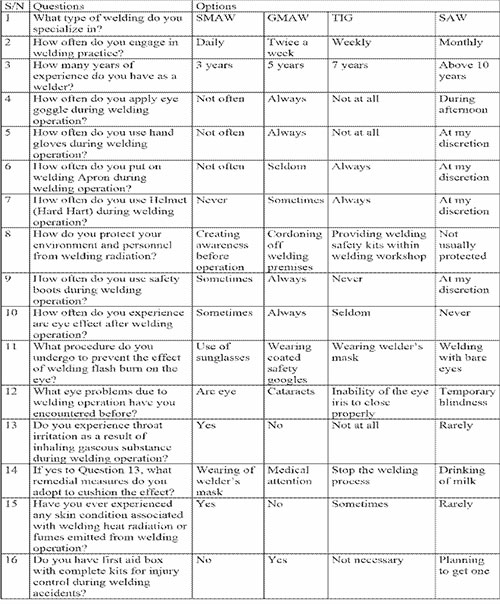

Figure 1: Respondents from question 1

Figure 2: Respondents from question 2
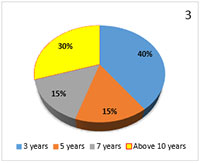
Figure 3: Respondents from question 3
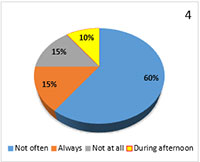
Figure 4: Respondents from question 4
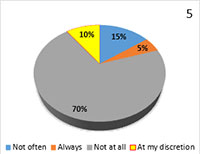
Figure 5: Respondents from question 5

Figure 6: Respondents from question 6
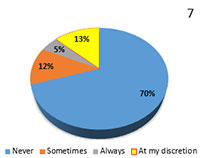
Figure 7: Respondents from question 7
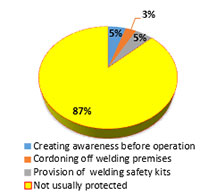
Figure 8: Respondents from question 8
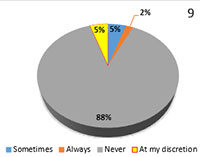
Figure 9: Respondents from question 9
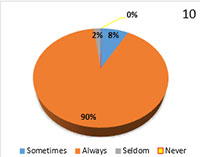
Figure 10: Respondents from question 10
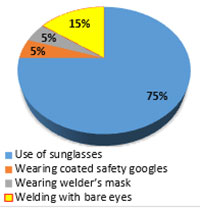
Figure 11: Respondents from question 11
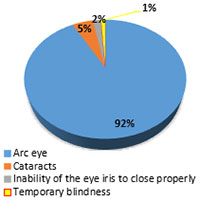
Figure 12: Respondents from question 12
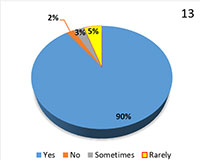
Figure 13: Respondents from question 13
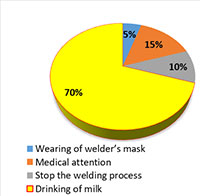
Figure 14: Respondents from question 14

Figure 15: Respondents from question 15

Figure 16: Respondents from question 16
This section presents the results obtained from the questionnaire designed for 100 welding respondents, to examine the perception of welding operators, practices of welding operations and their effects on the well-being of welding practitioners in Uyo, Akwa Ibom State Nigeria. Results obtained from the questionnaire is presented in Figures 1-16. Question 1 on the questionnaire looked into the type of welding specialized by each respondent (welding personnel) in this survey. As analysed in Figure 1, 80% of the respondents specialized in Shielded Metal Arc Welding (SMAW), and 10% of the welding personnel specialized in Tungsten Inert Gas (TIG) Welding/Metal Inert Gas (MIG). About 5% of the respondents indicated that they specialize in Tungsten Inert Gas (TIG) welding while 5% of the respondents opted for Submerged Arc Welding (SAW). During the survey exercise, most equipment found in the various metal workshops were fabricated using SMAW technique which also had over 80% respondents specializing on it. SMAW also called Manual Metal Arc Welding (MMAW) uses a consumable or flux-coated electrode, in which the flux-coated electrode during welding operation is consumed to form a protective layer of shielding gas and slag around the weld region.16 This type of welding is limited to short weld stints, since the consumable electrode requires constant replacement. However, versatility of the process as well as simplicity of its operation makes the technique dominate other welding processes as one of the world’s most popular welding process. The assessment in Question 2 was to determine how often welding operators engage in welding practice. As shown in Figure 2, about 80% of the respondents agreed to engage in welding practices on daily basis while 10% agreed to engage in welding practices twice a week. However, the survey revealed that 8% of the respondents engage weekly in welding practices while only 2% of the respondents stated that their engagement in welding practices is ones a month. This analysis further confirms SMAW as a very popular welding technique that a lot of operators are conversant with in Akwa Ibom State, Nigeria.
The years of experience acquired by a welding operator was very essential in this survey, as it played a major role in ascertaining the genuinity of feedback obtained from different respondents. In this case, the questionnaire was designed to determine the number of years that each operator have been practicing. From the feedback in Figure 3, over 40% of the respondents had put in 3 years, 30% had put in more than 10 years while 15% of the welding operators examined in this survey had put in 5 and 7 years respectively. This indicates that the feedback obtained from the survey do not lack essence and practical background but has an ideal basis considering the years that these operators have spent in their respective field of welding practice. Question 4 was designed to determine the frequency at which welding operators apply eye goggle during welding operation. This aspect is very essential in welding practice, and was incorporated into the questionnaire since it was observed in the course of the survey that a number of operators carry out welding practice without protecting the eye. As shown in Figure 4, the feedback obtained from different respondents in this survey revealed that 60% of operators do not often use eye goggle, 15% agreed to always use eye google, 15% responded to not using eye google at all while 10% agreed that they use eye google for welding operations only in the afternoon. The reason for applying eye google only in the afternoon is because the combine effects of arc radiation, ultraviolet rays and sun rays in the afternoon causes sleepless night and severe arc eye effect particularly at night.
Like the case of Question 4, the practice observed in most welding workshop necessitated the incorporation of Question 5 (see Figure 5) in the questionnaire, to examine how often operators use hand gloves during welding operation. Feedback obtained from different respondents (see plot in Figure 5) revealed that 70% of operators do not use hand gloves, 10% use hand gloves at their discretion, 15% do not often use it while 5% claim they always use hand gloves at every welding operation they are involved in. As shown in Figure 6, feedback from respondents revealed the negligence by welding operators on welding practice in Uyo, Akwa Ibom State, Nigeria. The welding apron is an important safety kit that protects the operators from hot sparks and heat during welding, cutting or grinding.17 The course of this survey, it was observed that several operators carryout welding operation without wearing an apron to cover themselves. As a result of that, Question 6 was designed to determine whether or not operators protect themselves during welding operation. As presented in Question 6, feedback obtained from different respondents revealed that over 80% of operators conduct welding operation without apron, 13% responded hat they use welding apron at their discretion, 5% asserted that they seldom use welding apron while 2% argued that they always use welding apron during welding operation. Similar to Question 5, this also indicates the poor welding practices in Uyo, Akwa Ibom State.
One of the most critical safety measures in welding operations is the use of a helmet. Question 7 examined how often helmet (Hard Hart) is used during welding operation. From Figure 7, 70% of the respondents indicated that they have never used a helmet during welding operation while 13% use helmet at their discretion. Furthermore, 12% of the correspondents sometimes use helmet while a handful (5%) make use of helmet during welding exercise. The intense heat generated during welding can reach temperatures of up to 10,000 degrees Fahrenheit, making it crucial to protect the head from burns.18 Without a helmet, welders risk direct contact with sparks, molten metal, and hot slag, leading to painful burns. These burns can range from minor to severe, requiring medical attention and potentially leaving permanent scars on the head.19,20
Question 8 examined how the environment and personnel are protected from welding radiation. As shown in Figure 8, 87% of the respondents revealed that the environment and personnel are not usually protected from welding radiation, 5% indicated they create awareness before the commencement of welding operation. However, 3% responded that the welding premises is cordoned off while 5% pointed out that this task is achieved by providing welding safety kits. Radiation is energy that moves through space or matter of a very high speed. This energy can be in form of particles, such as alpha or beta particles, which are emitted from radioactive materials or wave such as light, heat, radioactive waves, microwaves, x-rays and gamma reg.21 Radioactive materials also known as radionuclides or radioisotopes, are atoms that are unstable. In nature, there is a tendency for unstable atoms to change into a stable form as they change from welding radiations.22 Radiation may or may not be visible to the human eye. Ultraviolet (UV) radiation is a type of electromagnetic energy with wave length shorter than visible light. It is therefore invisible to the naked eye. Excessive exposures to the UV light pose certain risk to welding personnel.23
Question 9 involved the frequency at which safety boots are used during welding operation. Welding operations involve various hazards, including heat, sparks, and flying debris, which can cause severe injuries to workers. Safety boots are an essential personal protective equipment (PPE) that provide protection to the feet and lower legs. However, some individuals may overlook the importance of wearing safety boots during welding operations. The plot of response (see Figure 9) from the questionnaire generated in this study revealed that about 88% of welders operate without safety boots, 5% make use of safety boot at their discretion and 5% sometimes do. However, about 2% of the respondents asserted that the use of safety boots is a part of their daily safety routine during welding operation. It is crucial for employers and workers to prioritize safety by ensuring the use of appropriate personal protective equipment, including safety boots to protect the feet from potential injuries.24 Without safety boots, workers are exposed to various hazards such as falling objects, sharp metal pieces, and hot sparks. These hazards can cause severe injuries, including cuts, punctures, burns, and fractures.25 The absence of safety boots increases the vulnerability of workers to such injuries, leading to potential long-term consequences and work-related disabilities. Question 10 examined the frequency at which welding operators experience arc eye effect after welding operation. About 90% of the respondents as shown in Figure 10 indicated that they always experience arc eye effect after welding operation, and 8% of the respondents indicated that they sometimes have this experience. However, 2% of the respondents went for the option that they seldom experience arc eye while none of the respondents have never had this experience. The human eye is very sensitive to UV radiations. A short exposure for a few times can result in painful, but temporary condition known as arc eye, which causes inflammation of the cornea of the eye, thereby making it discharge watery substance and consequently blurring the vision.26 This condition is characterised by painful gritty feeling as if sand has entered the eyelids, watering of eyes and difficulty to tolerate light rays are also experienced simultaneously. This condition which subject its victims to a lot of inconvenience and severe pains in the eye does not manifest immediately after exposure, but may take 4-8 hours and normally takes 24-48 hours before it subsides. Therefore, excessive exposure of the conjuetivia (radiation of the, a membrane that covers the inside eye lid and the sclera, the white part of the eye) to UV during welding operation can cause the eye to swell and produce watery discharge.27,28
Question 11 assessed the procedures undergone by welding operators to prevent the effect of welding flash burn on the eye. Responses from question 11 (see plot in Figure 11) obtained from respondents in the questionnaire revealed that about 75% of welders operate with sunglasses, 15% weld with bare eyes, 5% wear coated safety googles while 5% make use of welder’s mask. One of the most common hazards associated with welding is flash burn, also known as arc eye or welder's flash.29 This condition occurs when the eyes are exposed to the intense ultraviolet (UV) radiation emitted during welding, leading to painful symptoms and potential long-term damage. To safeguard the eye health of welders, it is crucial to implement a comprehensive set of procedures aimed at preventing the effects of welding flash burn.30 These includes the use of welding screens and curtains, adequate ventilation, and adequate eye protection with face shield that complies with industry standards, such as the American National Standards Institute (ANSI) Z87. Regular eye examinations are also essential for welders to detect any early signs of eye damage caused by welding flash burn, as early detection of eye injuries allow for timely intervention and prevents further complications.31
Question 12 concerned the eye problems encountered by welders during welding operation. Plot of respondents (see Figure 12) obtained from the questionnaire indicates that 92% of welding practitioners experience arc due to regular welding operation, about 5% experiences eye problem known as cataracts, 2% experience eye problem characterised by in ability of the eye iris to close properly while 1% of welding practitioners encounter temporary blindness. Arc eye, also known as welder's flash or photokeratitis, is a painful condition caused by exposure to intense ultraviolet (UV) radiation emitted during welding.32 Welder's flash primarily affects the cornea, resulting in symptoms such as redness, tearing, sensitivity to light, and a gritty sensation in the eyes. Prolonged or repeated exposure to UV radiation without proper eye protection can lead to long-term damage, including cataracts and macular degeneration. Also, sparks, molten metal, and debris are generated during welding operations, posing a risk of eye injury.33 These particles can cause corneal abrasions, foreign body sensation, and even penetrate the eye, leading to severe damage or vision loss. The high temperatures involved in welding can also cause these particles to be ejected at high velocities, making eye protection crucial. To mitigate the risks associated with welding operations, it is essential for welders to adopt appropriate protective measures. The use of personal protective equipment (PPE) is crucial in safeguarding the eyes. Welding helmets with appropriate shade levels, safety glasses with side shields, and face shields provide effective protection against UV and IR radiation, sparks, and debris. Regular maintenance and replacement of PPE are necessary to ensure optimal protection.
Throat irritation is a common symptom experienced by individuals exposed to welding fumes. The primary cause of this irritation is the inhalation of gaseous fumes released during welding operations.34 These fumes contain a mixture of toxic substances, including metal oxides, ozone, and nitrogen oxides, which can irritate the respiratory system upon inhalation. The throat, being a part of the respiratory system, is particularly susceptible to the effects of these fumes. In Question 13 (see plot in Figure 13) which involves throat irritation due to inhalation of gaseous substance during welding operation, 90% of the respondents agreed that they experience throat irritation due to welding, 5% responded that they rarely have such experience, 3% responded that they sometimes have the experience while 2% of the respondents revealed that they do not throat irritation due to welding practice. In Question 14, 70% of the respondents prefer drinking milk to minimise the effects of throat irritation due to welding process, 15% prefer seeking medical attention, 10% prefer stopping welding practice until the effect subsides, while 5% prefer wearing of welder’s mask as shown in Figure 14. Prolonged exposure to welding fumes can lead to more severe health issues such as inflammation in the respiratory system. To mitigate this, appropriate PPE such as respirators and face shields should be used. Additionally, proper ventilation systems (wall exhaust panel fans, duct fans, roof exhaust fans, source capture blower etc.) should be installed in welding areas to reduce the concentration of toxic substances in the air and ensure the removal of fumes from the workplace.
Welding heat radiation can cause various skin conditions due to the intense heat generated during the process. One common condition is thermal burns, which occur when the skin is exposed to high welding temperatures. Welders are at risk of thermal burns, especially in areas where protective clothing may not cover the skin adequately.35 These burns can range from mild to severe, depending on the duration and intensity of exposure. Question 15 was raised to determine if and how often welding operators experience skin conditions associated with welding heat radiation or fumes emitted from welding operation. As shown in Figure 15, feedback obtained from respondents indicate that 88% of welding operators do have such experience, 10% of the respondents agreed that they sometimes experience skin conditions due to welding operation. Moreover, 2% of the respondents revealed that they rarely have such experience while none of the respondents indicated that they do not encounter skin condition. One skin condition associated with welding heat radiation is erythema, commonly known as welder's sunburn. Erythema occurs due to prolonged exposure to ultraviolet (UV) radiation emitted during welding. This condition manifests as redness, inflammation, and pain on the exposed skin. If left untreated, erythema can progress to more severe conditions such as skin cancer. Another common skin condition associated with welding fumes is contact dermatitis.36 Welders who come into direct contact with metal dust or fumes may develop an allergic reaction, resulting in redness, itching, and swelling of the skin. Prolonged exposure to these irritants can lead to chronic dermatitis, which requires medical intervention. Another skin condition linked to welding fumes is acneiform eruptions. These eruptions resemble acne and are caused by the deposition of metal particles on the skin. The trapped particles can clog pores, leading to the development of pustules and papules. Acneiform eruptions can be both physically uncomfortable and aesthetically displeasing for welders. To mitigate this, welders should wear appropriate personal protective equipment (PPE), including flame-resistant clothing, gloves, and face shields. Furthermore, adequate ventilation systems should be in place to control the dispersion of welding fumes. Proper ventilation helps reduce the concentration of harmful particles in the air, minimizing the risk of skin contact. Regular skin inspections and hygiene practices are also crucial.
Welding operations involve various hazards, including burns, eye injuries, and electrical shocks. To ensure the safety and well-being of workers, it is crucial to have a well-equipped first aid box readily available on-site. Question 16 examined the importance and awareness of first aid boxes with complete kits by welding operators. From the respondence shown in Figure 16, 89% of welding operators indicated that first aid box with complete kits is not necessary in their line of work, 5% of the entire welding operators examined indicated that they are planning to get one. However, 4% agreed that they have one while 2% revealed that they have none despite the fact that the know the relevance of first aid boxes with complete kits. The relevance of a first aid box with complete kits during welding operations are highlighted as follows:
- During welding operations, accidents can occur unexpectedly, resulting in injuries. Having a first aid box with complete kits allows for immediate response to injuries, minimizing the severity and potential complications. Prompt treatment can prevent further damage and promote faster recovery.
- Welding involves high temperatures, which increases the risk of burns and thermal injuries. A well-stocked first aid box should contain burn dressings, sterile gauze, and burn ointments to provide immediate relief and prevent infection. These supplies enable workers to administer initial treatment before professional medical assistance arrives.
- Welding operations expose workers to intense light, sparks, and debris, making them susceptible to eye injuries. A first aid box should include eye wash solutions, sterile eye pads, and eye drops to flush out foreign particles and soothe the eyes. These supplies can prevent further damage and reduce the risk of long-term vision impairment.
- Welding equipment operates on high electrical currents, increasing the likelihood of electrical shocks. A comprehensive first aid box should contain non-conductive gloves, adhesive bandages, and antiseptic solutions to treat electrical burns and wounds. These supplies aid in stabilizing the injured worker until professional medical help arrives.
- Sharp tools and metal fragments used in welding operations can cause cuts and abrasions. A well-equipped first aid box should include adhesive bandages, sterile dressings, and antiseptic wipes to clean and cover wounds. These supplies help prevent infection and promote proper wound healing.
- Welding produces hazardous fumes and gases that can be harmful if inhaled. While a first aid box cannot directly address this issue, it can contain respiratory masks or face shields to protect workers from inhaling toxic substances. These supplies act as a preventive measure, reducing the risk of respiratory complications.
The relevance of a first aid box with complete kits for injury control during welding operations cannot be overstated. It provides immediate access to essential supplies, enabling workers to administer initial treatment and stabilize injuries until professional medical help arrives. By having a well-equipped first aid box readily available, welding operators demonstrate their commitment to the safety and well-being of their workforce.
The survey revealed that welding operators are exposed to various physical hazards during their work. These hazards include exposure to harmful fumes, gases, and particulate matter, as well as excessive noise levels and intense heat. Prolonged exposure to these hazards can lead to serious health issues such as respiratory problems, hearing loss, and thermal injuries. Therefore, it is crucial for welding operators to be equipped with appropriate personal protective equipment (PPE) to minimize their exposure to these hazards. Furthermore, the survey highlighted the importance of proper ventilation systems in welding workplaces. Adequate ventilation is essential to remove hazardous fumes and gases generated during welding processes. The lack of proper ventilation can result in the accumulation of toxic substances in the air, posing a significant risk to the health of welding operators. Employers should ensure that effective ventilation systems are in place to maintain a safe working environment for welding operators. Additionally, the survey emphasized the significance of training and education for welding operators. Proper training programs should be implemented to educate operators about the potential hazards associated with welding practices and the necessary safety precautions to mitigate these risks. Welding operators should be trained on the proper use of PPE, safe welding techniques, and the importance of regular health check-ups. By providing comprehensive training, employers can empower welding operators to protect themselves and their colleagues from potential health hazards. Moreover, the survey revealed the importance of regular health monitoring for welding operators. Routine health check-ups can help identify any early signs of health issues caused by welding practices. Employers should establish a system for regular health assessments, including lung function tests, hearing tests, and thermal injury evaluations. Early detection of health problems can lead to timely interventions and prevent further deterioration of the well-being of welding operators.
Conclusion and Recommendations
The physical survey conducted on the practices of welding operations and their effects on the well-being of welding operators highlights the significant health risks associated with this occupation. It has also highlighted the importance of implementing proper safety measures, providing comprehensive training, conducting regular health monitoring, and further research in the field. The study has highlighted the potential health hazards associated with welding operations and the need for proper safety measures to protect the well-being of welding operators. The findings of this survey have significant implications for both the welding industry and the occupational health and safety sector. Furthermore, the study indicated that the exposure to toxic fumes, intense heat, and harmful radiation can lead to various respiratory issues, burns, and long-term health complications. However, by implementing preventive measures such as adequate ventilation, the use of PPE, and comprehensive training programs, the well-being of welding operators can be significantly improved. In light of the findings from this physical survey, the following recommendations are suggested to improve the well-being of welding operators.
- Employers should prioritize the implementation of effective safety measures, including the provision of appropriate PPE and the installation of proper ventilation systems. Regular maintenance and inspection of equipment should also be conducted to ensure their effectiveness.
- Adequate ventilation systems should be installed to minimize exposure to welding fumes. Local exhaust ventilation (LEV) systems, such as fume extraction hoods, can effectively capture and remove welding fumes at the source, reducing the risk of respiratory issues.
- Comprehensive training programs should be developed and implemented to educate welding operators about the potential hazards and safety precautions associated with their work. These programs should be regularly updated to incorporate new findings and best practices in the field of welding safety.
- Employers should establish a system for regular health monitoring of welding operators. This can be achieved through periodic health check-ups and the maintenance of accurate health records. Early detection of health issues can lead to timely interventions and prevent long-term health complications.
- Further research should be conducted to explore additional measures that can be taken to improve the well-being of welding operators. This research should focus on the development of advanced PPE, innovative ventilation systems, and the evaluation of the long-term health effects of welding practices.
By addressing these recommendations, the welding industry can ensure the well-being of its operators and create a safer working environment.
Acknowledgement: The authors of this paper acknowledge Dr. Edidiong Akpan of the University of Uyo Teaching Hospital for his contributions, guidance and tutelage in the course of this study.
References
- Bassey MO, Offiong U, Ikpe AE. Finite Element Simulation for Thermo-Mechanical Transient Behaviour of Mild Steel Plate Agglutinated by Gas Tungsten Arc Welding (GTAW) Technique. J Mat Eng Struct Compt. 2023;2(3):71-91.
- Ikpe AE, Bassey MO. Modelling and Simulation of Transient Thermal Stress Distribution across AISI 1018 Flat Plates at Variable Welding Temperature Regime. J Mat Eng Struct Compt. 2023;2(3):1-22.
- Owunna I, Ikpe AE. Finite Element Analysis of Tungsten Inert Gas Welding Temperatures on the Stress Profiles of AIS1 1020 Low Carbon Steel Plate. Int J Eng Tech. 2019;5(2):50-58.
- Sharma H, Rajput B, Singh RP. A review paper on effect of input welding process parameters on structure and properties of weld in submerged arc welding process. Mat Today: Proceedings. 2020;26:1931-1935.
- Owunna IB, Ikpe AE, Ohwoekevwo JU. Application of SEM/EDS in Fractographic Investigation of TIG Welded AISI 1020 Fusion Zones at Distinct Welding Current Steps. Arid Zone J Eng Tech Env. 2022;18(2):255-266.
- Fening PA, Agyei IK, Baah SK, Adala CE. Safety, Practices and Associated Healthy Hazards among Informal Welders in Kumasi Workplace, Ghana. Design Eng. 2021;8:17221-17235.
- Aliyu AA, Amadu L. Urbanization, cities, and health: The challenges to Nigeria - A review. Annal Afr Medicine. 2017;16(4):149-158.
- Ikechukwu CU, Ibukun BI, Zubair OM. Design and Fabrication of an Electrically Powered Rotary Slicer for Raw Plantain Chips Production. Amer J Eng Res. 2014;3(4):38-44.
- Adu E, Danquah A. Welding practices in selected metal welding industries in Ghana. Int J Sci Eng. 2016;7(6):462-473.
- Beji AA, Muhammad PH, Yassar AA, Suleiman HG. Hazard Evaluation of Welding and Fabrication Workshops in Minna Metropolis, Nigeria. Iconic Res Eng J. 2022;6(3):29-33
- Yetunde OT, Chundung AM, Martin DG, Pankyes DY, James AI, Moses PC. Risk assessment of welding workshops in Jos, Nigeria. Int J Biomed Res. 2018;9(6):226-230.
- Belmoro BJB, Gumasing MJ. Antecedents of Safety and Health in the Workplace: Sustainable Approaches to Welding Operations. Sustainability. 2023;15:14641.
- Mehrifar Y, Zamanian Z, Pirami H. Respiratory Exposure to Toxic Gases and Metal Fumes Produced by Welding Processes and Pulmonary Function Tests. Int J Occupational Medicine Env. 2019;10(1):40-49.
- Ko UW, Kyung SY. Adverse Effects of Air Pollution on Pulmonary Diseases. Tuberculosis and Respiratory Diseases. 2022;85(4): 313-319.
- Ottah UN, Okokon EO, Okoi NO, Akpan UB, Etokidem AJ, Asibong IU, et al. Use of the partograph among obstetric care providers in government healthcare facilities in Uyo Senatorial District, Akwa Ibom State, Nigeria. Afr J Medical Health Sci. 2023;23(3):34-42.
- Arifin AA. Dissimilar metal welding using shielded metal arc welding: A Review. Tech Rep Kansai Uni. 2020;62(4):1935-1948.
- Kasar SR, Naikwadi GB, Gurav VV. Hazard Identification and Risk Assessment of Hot Work Area at Swargate Underground Metro Station Site, Pune. Int J Creative Res Thoughts. 2021;9(4):2463-2476.
- Mgonja CT. The Effects of Arc Welding Hazards To Welders And People Surroundingthe Welding Area. Int J Mech Eng Tech. 2018;8(3):433-441.
- Krewski D, Yokel RA, Nieboer E, Borchelt D, Cohen J, Harry J, et al. Human health risk assessment for aluminium, aluminium oxide, and aluminium hydroxide. J Toxicology and Env Health, Part B. 2007;10(1):1-269.
- John A, Nwaoha TC. A Review on Operational Hazards of Welding Processes. FUW Trends Sci Tech J. 2018;3(2):595-599.
- Brune D, Hellborg R, Persson BRR, Pääkkönen R. Radiation at Home, Outdoors and in the Workplace. Scandinavian Science Publisher, Norway, 2001.
- Abojassim AA, Hashim RH. Mahdi NS. Basics of Nuclear Radiation, BP. International. 2021;20:1-86.
- Otokpa OE, Usman YB. An Assessment of Ultraviolet Radiation Components of Light Emitted from Electric Arc and their Possible Exposure Risks. Global J Pure and Appl Sci. 2013;19:145-149.
- McCarthy R, Gino B, d'Entremont P, Barari A, Renouf TS. The Importance of Personal Protective Equipment Design and Donning and Doffing Technique in Mitigating Infectious Disease Spread: A Technical Report. Cureus. 2020;12(12):e12084.
- Machin H. Protecting yourself at work. Community Eye Health. 2015;28(90):28-39.
- Marro M, Moccozet L, Vernez D. Assessing Human Eye Exposure to UV Light: A Narrative Review. Front in Pub Health. 2022;10:900979.
- Oblak E, Doughty MJ. Chronic exposure to the ultraviolet radiation levels from arc welding does not result in obvious damage to the human corneal endothelium. Photochemical and Photobiological Sci. 2002;1(11),857-864.
- Kumah DB, Cobbina F, Duodu DJ. Radiation-Related Eye Diseases among Welders of Suame ‘Magazine’ in the Kumasi Metropolis. J Sci Tech. 2011;31(1):37-43.
- Chauhan A, Anand T, Kishore J, Danielsen TE, Ingle GK. Occupational hazard exposure and general health profile of welders in rural Delhi. Indian J. Occupational Env Medicine. 2014;18(1):21-26.
- Sithole HL, Oduntan OA, Oriowo MO. Eye protection practices and symptoms among welders in the Limpopo Province of South Africa. South Afr Optometrist. 2009;68(3):130-136.
- Kwaku TKK, Owusu R, Axame WK. Prevalence and Factors Influencing Eye Injuries among Welders in Accra, Ghana. Adv Preventive Medicine. 2020;16:2170247.
- Izadi M, Jonaidi-Jafari N, Pourazizi M, Alemzadeh-Ansari MH, Hoseinpourfard MJ. Photokeratitis induced by ultraviolet radiation in travelers: A major health problem. J Postgraduate Medicine. 2018;64(1):40-46.
- Hong TS, Ghobakhloo M. Safety and Security Conditions in Welding Processes. Comprehensive Mat Processing. 2014;6:213-225.
- Fikayo BE, Chimezie OV, John SK, Omotola OJ, Mbon IC, Eleonu PC, et al. (2023) Occupational Exposure to Welding Fumes and Associated Respiratory Morbidities among arc Welders in Ikenne, Nigeria. Ethiopian J Health Sci. 2023;33(2):373-382.
- Falcone LM, Zeidler-Erdely PC. Skin cancer and welding. Clinical and Exp Dermatology, 2019;44(2),130-134.
- Kim D, Kim AR, Kim H, Lee S, Seo B, Suh HS, et al. Nickel dust-induced occupational contact dermatitis by welding and grinding work in shipyard workers: a report of nine cases. Annals of Occupational and Environmental Medicine. 2022;34:e7.